The Porsche 968 Story
The Porsche 944 S3
Full Story / Model Guides / Research & Data / Timeline & Evolution / Performance / Videos & Pics / FAQs / News
Manufacturer: Porsche AG
Production Years: 1991 - 1995
Production: 12,780 units
Designer: Harm Lagaay
Body style: 2-door coupé & convertible
Layout: Front-engine, RWD
Engines: 3.0 L M44/12 16-valve Inline 4, 3.0 L 8-valve turbocharged Inline 4
Transmissions: 6-speed manual, 4-speed tiptronic automatic
Wheelbase: 2,400 mm (94.5 in)
Length: 4,320 mm (170.1 in)
Width: 1,735 mm (68.3 in)
Height: 1,275 mm (50.2 in)
Curb weight: 1,400 kg (3,100 lb)
Premiere: September 12, 1991 IAA Frankfurt Motor Show press day
Predecessor: Porsche 944
Successor: Porsche Boxster (986)
The 968 was almost called the 944 "S3", an upgrade to the "968 S2" that Porsche had introduced in 1989. With over 80% of the 944's components new or modified, Porsche decided instead to introduce the car as a new model, hence the 968 was born. Production was moved from the Audi plant in Neckarsulm (where the Porsche 924 and Porsche 944 had been made) to Porsche's own factory in Zuffenhausen. The 968 was produced from 1992 to 1995 and was marketed as the replacement for the Porsche 944. When production ceased in the 1995 model year, it represented the end of a line started almost 20 years earlier with the introduction of the Porsche 924. By late 1991, the 968 was ready. It retained all the good bits of its predecessor, while significantly improving appearance, handling, and performance. The 968 was introduced in September 1991 at the Frankfurt Motor Show as a 1992 model.
The big news new model was the engine. The 968 got an updated version of the 944’s straight-4 engine, now displacing 3.0 L and producing 236 bhp @ 6200 rpm and 225 lb-ft @ 4100 rpm of torque. Changes to the 968's powertrain also included the VarioCam variable valve timing system, a new dual resonant induction, a new exhaust systems with a rare metals catalytic converter, a dual-mass flywheel, and updated engine management electronics. A new 6-speed manual transmission was offered, as well as a dual-mode Tiptronic automatic. The options were plentiful, the most interesting of which was the M030 suspension.
The 968's styling somewhat resembled the 928 although it looks considerably more like a blend of the 993 911, which did not appear until the end of the 968's production and a 944 S2. Like the 944, the 968 was sold as both a coupe and a convertible. Much of the 968's chassis was carried over from the 944S2, which in itself shared many components with the 944 Turbo (internally numbered 951). Borrowed components include the Brembo-sourced 4-piston brake calipers on all four wheels, aluminum semi-trailing arms and aluminum front A-arms, used in a MacPherson strut arrangement. The galvanized steel Unibody structure was also very similar to that of the previous models.
Performance models were also released. A street-legal race variant, dubbed Club Sport, appeared in 1994 with a stripped-out interior including racing seats, revised suspension, and larger wheels and tires, but was offered only in Europe. A UK-only version called 968 Sport, a Club Sport model with some comfort features added back in, was produced in 1994 and 1995. Porsche briefly produced a turbocharged version called Turbo S, of which only 15 were produced, and again was only sold in Europe. The 968 Turbo S was capable of 0–60 mph in 4.5 s and top speed of 175 mph. A race variant called 968 Turbo RS was added as well; only 4 were produced and raced with some success.
Over the 4 years of production, only 12,780 cars were sold worldwide, with less than 5,000 shipped to North America. Original sales price started at about $55,000 and dropped dramatically by the end of production, as lower priced Japanese competition, and the unwillingness of the public to embrace a front engine 4 cylinder Porsche spelled doom for the 968. The 968 was Porsche’s last new front-engined vehicle before the introduction of the Cayenne SUV in 2003. It was sold alongside the 928 GTS through 1995 when both models were dropped.
Below we take a look at the performance and specifications for the core production model Porsche 968s.
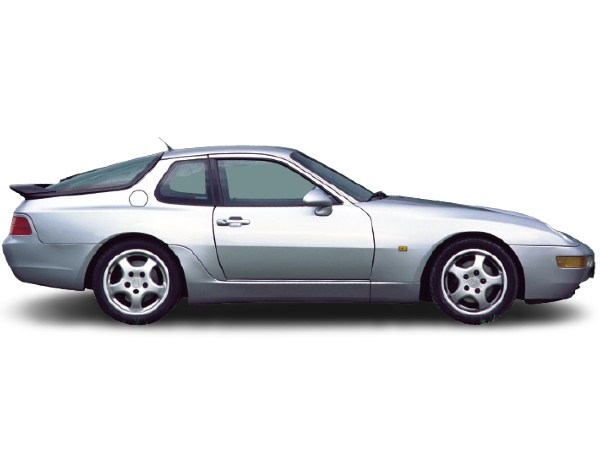
The 968 was powered by an updated version of the 944's Inline-four engine, now displacing 3.0 L with a 104 mm bore and a 88 mm stroke and rated at 240 PS (177 kW; 237 hp) at 6,200 rpm and 305 N⋅m (225 lb⋅ft) of torque at 4,100 rpm. Modifications to the engine include a higher 11.0:1 compression ratio, lighter crankshaft, crankcase and pistons along with revised intake valves and intake manifold.
Changes to the 968's powertrain also included the addition of Porsche's then-new VarioCam variable valve timing system, newly optimized induction and exhaust systems, a dual-mass flywheel, and updated engine management electronics. For the 1993 model year, the 968 received minor changes, mainly focused on air conditioner and the introduction of special packages and options.
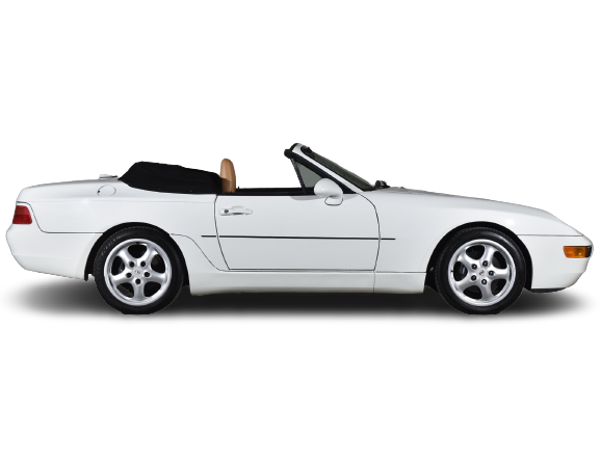
Like its predecessor, the 968 was offered in coupé and convertible bodystyles. All Porsche 968 cabriolets started life as coupes and were converted into cabriolet form by ASC in Heilbronn Germany. Upon conversion they were shipped back to Zuffenhausen for final assembly alongside the 911 and 928.
North American spec 968 cabriolets were offered with the full range of Porsche factory-based options as well as the exterior and interior color choices. Unlike ROW (Rest of World) 968s, Cabriolets destined for the US were 2 seaters and outfitted with a double glove box/package tray unit where the rear seats would typically be found.
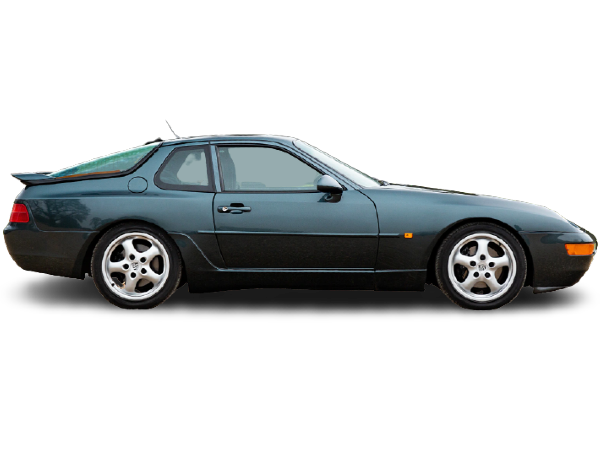
A UK-only version called "968 Sport", was offered in 1994 and 1995, and was essentially a Club Sport model (and was produced on the same production line with similar chassis numbers) with power windows, electric release boot, central locking, cloth comfort seats (different from both the standard and the Club Sport). With the added electrics the larger wiring loom was used.
The Sport Variant also got back the two rear seats, again in the cloth material specific to the Sport. At £29,975, the 968 Sport was priced £5,500 lower than the standard 968, but had most of the latter's desirable "luxuries" and consequently outsold it by a large margin (306 of the 968 Sport models compared to 40 standard 968 coupés).
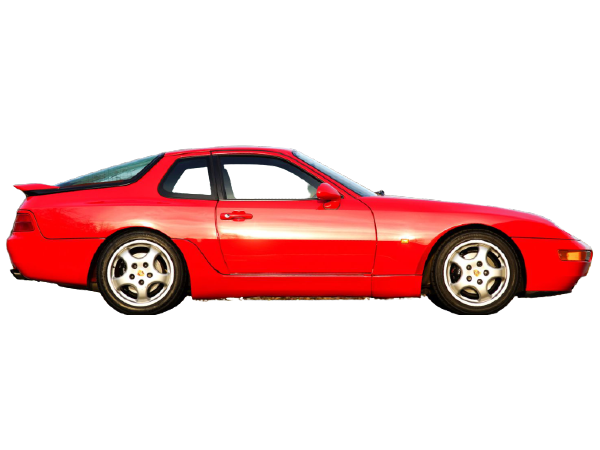
From 1993 through 1995, Porsche offered a lighter-weight "Club Sport" version of the 968 designed for enthusiasts seeking increased track performance. Much of the 968's luxury-oriented equipment was removed or taken off the options list; less sound deadening material was used, power windows were replaced with crank-driven units, upgraded stereo systems, A/C and sunroof were still optional as on the standard coupé and Convertible models.
In addition, Porsche installed manually adjustable lightweight Recaro racing seats, a revised suspension system, 17-inch wheels and wider tires. The four-spoke airbag steering wheel was replaced with a thicker-rimmed three-spoke sports steering wheel with no airbag, heated washer jets were replaced with non heated, vanity covers in the engine bay were deleted, as was the rear wiper. The Club Sport has no rear seats, unlike the 2+2 Coupé.
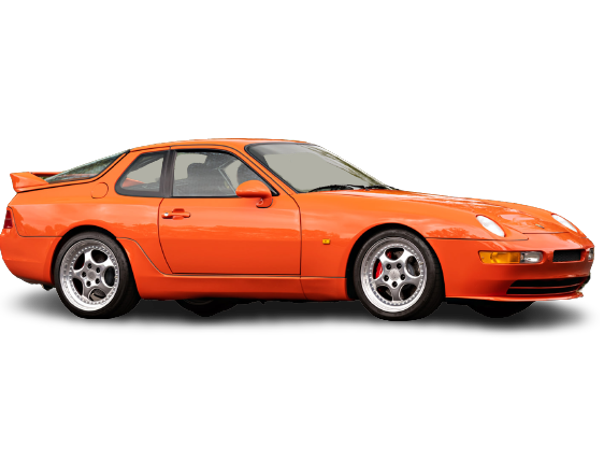
In 1993, Porsche Motorsports at Weissach briefly produced a turbocharged 968 Turbo S, a fairly odd naming choice for Porsche which usually reserves the added "S" moniker for models that have been tuned for more power over a "lesser" counterpart, such as with the 911 Turbo. The 968 Turbo S shared the same body and interior as the Club Sport and visually can be identified by the NACA bonnet hood scoops, adjustable rear wing, three-piece speedline wheels and deeper front spoiler.
The car had the suspension lowered by 17.8 mm (0.7 in) and was 20 kg (45 lb) lighter than the standard 968. The 968 Turbo S was powered by a 3.0 L engine with a 8-valve SOHC cylinder head (from the 944 Turbo S) and 944S2 style engine block. Tests conducted in 1993 returned a 0 to 97 km/h (60 mph) time of 4.7 seconds and a top speed of 282 km/h (175 mph). The engine generated 309 PS (227 kW; 305 hp) at 5,600 rpm with a maximum torque of 500 N⋅m (369 lb⋅ft) at 3,000 rpm. Only 14 were produced in total.
For those who want to see the Porsche 968 in all its glory, our Porsche 968 Pictures, Galleries & Wallpapers section features a stunning collection of high-quality images, including factory photos, rare color options, historical advertisements, and downloadable wallpapers for enthusiasts.
Experience and enjoy the fabulous Porsche 968 in these fun videos we curated from across the internet.
Coupes have a standard ride height, CS and Sport have 20mm shorter front springs and rear torsion bars are 20mm lower.
Coupes has leather seats or sport leather (electrically adjustable). The CS has fibre glass bucket race seats. The 968 Sport has cloth 'comfort' seats.
Coupe has vinyl rear occasional seats. CS has a shelf extending the rear luggage area. Sport has cloth rear occasional seats added back in.
Coupes prior to '93 have 3 spoke steering wheel. Then 4 spoke airbag steering. CS and Sport have the 3 spoke CS steering with thick rim (no airbag).
Coupes have an analogue clock in centre console and a digital temp gauge on dash. CS and Sports have a digital clock on dash with a stopwatch.
Coupes have standard sound proofing, CS and Sports have reduced sound proofing.
Coupes have updated door cards, CS and Sport have the older 944 door cards.
Coupes have the 6 speaker stereo system, CS and Sports have 2 speakers.
Coupes have 16" Cup 1 alloy wheels, CS and Sports have 17" Cup 1 or Cup 2 alloys
Coupes have black plastic vanity covers in the engine bay, CS and Sport don't have these.
Coupes standard battery and wiring loom. CS have a smaller battery, alternator and lighter wiring loom. Sports have standard battery and wiring loom.
Coupes have a rear wiper. Deleted on the CS and Sport and replaced with a watertight cover on the hole in the tailgate glass ('wiper delete bung').
Coupes have heated windscreen washer jets, Club Sports do not.
Coupes have an underbonnet light, Sport and Club Sport do not.
Coupes were available in many different colors, and had options on the interior colors, seats and trim. Club Sports were available in Guards Red, Speed Yellow, Black, White, Maritime Blue and Riviera Blue with or without Club Sport decals down the sides in either black, red or white. Club Sports had colour coded backs to the front seats and a black interior. Sports were available in many different colors, and had black cloth seats and an all black interior.
The Sport (for the UK market only in 1994) was produced on the same production line as the Club Sport so is very similar in the chassis (chassis numbers correspond) and suspension. The key difference between the CS and the Sport is that the Sport has the bigger wiring loom and battery - for the extra electrics that have been put in, electric windows, tailgate release, central locking etc. It also has the occasional rear seats, unlike the CS and it has the comfort front seats. Generally the Sport is a CS with the electrics added in and comfort seats.
A transaxle Porsche refers to a front-engine Porsche model that uses a transaxle layout—where the engine is in the front and the transmission is mounted at the rear, connected by a torque tube. This design creates near-perfect 50:50 weight distribution, dramatically improving balance and handling. The most well-known transaxle Porsches include the 924, 944, 968, and 928. Porsche adopted this layout to give these cars a different dynamic character from the rear-engined 911, prioritizing stability, predictable cornering, and everyday usability. Today, transaxle Porsches are celebrated for their engineering sophistication, driving feel, and rising collectibility.
The Porsche 968 was designed under the direction of Harm Lagaay, who was head of Porsche’s styling department at the time. Lagaay had previously worked for Porsche in the early 1970s, then at BMW and Ford, before returning to Porsche in the late '80s.
While the 968 shares its platform with the earlier 944, Lagaay gave it a more refined and cohesive look, incorporating design elements that would later influence models like the 993-generation 911. The 968 featured integrated body-colored bumpers, smoother lines, and fixed headlights behind flush covers, giving it a modern, aerodynamic shape that marked a significant evolution from the more angular 924 and 944.
The result was a car that felt both familiar and forward-thinking, bridging the gap between the transaxle era and the more contemporary designs Porsche would pursue in the 1990s.
The Porsche 968 was built at Porsche’s main factory in Zuffenhausen, Germany, which marked a significant shift from earlier transaxle models like the 924 and 944 that had been assembled at the Audi plant in Neckarsulm.
By bringing production back in-house, Porsche aimed to improve quality control and align the 968 more closely with the brand’s core identity. The move to Zuffenhausen also reflected Porsche’s desire to treat the 968 as a more premium, refined model—closer in spirit to the 911, and representing the final and most advanced evolution of the front-engine, rear-transaxle Porsche lineage.
The Porsche 968 is powered by a single, highly advanced engine variant—a 3.0-liter inline-four, which was one of the largest and most sophisticated four-cylinder engines in production at the time.
Specifically, it’s a 3.0L DOHC 16-valve Inline-Four (M44/12). Exact displacement of 2,990 cc and a power output of 236 hp @ 6,200 rpm (European spec) and 236 hp @ 6,200 rpm (U.S. spec—same output, slightly different tuning). Torque was 225 lb-ft @ 4,100 rpm. Fuel Injection was handled by Bosch Motronic and the engine had a compression Ratio of 11.0:1 and a redline of 6,500 rpm.
This engine featured VarioCam, Porsche’s variable valve timing system, which adjusted intake cam timing for improved torque and efficiency across the rev range—making the 968 feel flexible and responsive at both low and high speeds.
The 3.0L engine was used across all production 968s from 1992 to 1995, whether coupe or cabriolet, manual or Tiptronic. A turbocharged version of this engine—producing well over 300 hp—was used in extremely rare factory variants like the 968 Turbo S and 968 Turbo RS, but these were produced in very limited numbers and primarily for racing or homologation purposes.
This engine was a refined evolution of the unit found in the 944 S2 and remains one of the most torquey and sophisticated naturally aspirated four-cylinder engines ever installed in a production sports car.
The Porsche 968 was quietly innovative—a refined culmination of Porsche’s decades-long development of its front-engine, rear-transaxle platform. Though it didn’t shout for attention like a 911 Turbo, the 968 was packed with engineering sophistication and subtle advancements that made it one of the most well-balanced and capable sports cars of its era.
At the heart of its innovation was the 3.0-liter DOHC inline-four, the largest four-cylinder production engine of its time. With VarioCam, Porsche’s variable valve timing system, the 968 delivered a broad torque curve and impressively smooth power delivery—making it equally comfortable in daily driving or spirited runs through mountain passes. It was mated to a six-speed manual transmission (a first for a Porsche road car), offering a precise and engaging shift feel that helped the car feel thoroughly modern in the early '90s.
What truly set the 968 apart, though, was its handling. Thanks to the transaxle layout—front engine, rear-mounted gearbox—the 968 had near-perfect 50:50 weight distribution, resulting in outstanding chassis balance and predictable cornering behavior. Combined with a rigid chassis, precise steering, and optional M030 sport suspension, the 968 was often described by reviewers as feeling more intuitive and balanced than its 911 counterparts.
Aesthetically, it was also a design evolution. With smoother, integrated bumpers, flush lighting, and a more cohesive silhouette, it looked fresh and forward-thinking while still unmistakably Porsche.
In many ways, the 968 was a bridge between Porsche’s past and future—an analog driver’s car refined to its highest form just before the brand moved into a more digital, modern era. That blend of usability, sophistication, and precision is what continues to make it special today.
The Porsche 968 is no slouch—especially for a naturally aspirated four-cylinder sports car from the early 1990s. Its performance was impressive for the time and still feels lively and engaging today.
Here are the key performance stats:
0–60 mph (manual coupe): ~ 5.9 to 6.2 seconds
Top speed: ~ 156 mph (251 km/h)
Horsepower: 236 hp @ 6,200 rpm
Torque: 225 lb-ft @ 4,100 rpm
Thanks to its 3.0-liter DOHC inline-four (the largest four-cylinder in a production car at the time), paired with a 6-speed manual transmission and excellent weight distribution, the 968 delivers linear, torque-rich power and a highly responsive driving experience. The torque curve is broad, making the car feel eager in both low-speed corners and high-speed cruising.
Performance varies slightly depending on transmission and body style—Tiptronic automatics are a bit slower, and cabriolets carry a bit more weight—but even those models feel quick and composed. In short, while the 968 may not be supercar-fast by today’s standards, it’s plenty fast enough to be fun, especially given its balance, responsiveness, and the level of driver engagement it offers.
Yes, the Porsche 968 was used in motorsport—most notably in one-make racing series, endurance events, and amateur club racing. While it didn’t have the same racing pedigree as the 911, the 968’s balance, durability, and refined chassis made it a solid platform for competition, especially in the hands of privateers and within Porsche-supported series.
Porsche developed the 968 Club Sport (CS) specifically with track use in mind. This lightweight, stripped-down version featured manual windows, no rear seats, fixed-back Recaro buckets, and the M030 sport suspension package—making it a factory-ready track car. It was particularly popular in European one-make racing series during the early to mid-1990s, including Porsche Club racing and regional championships.
The ultimate motorsport version of the 968 was the 968 Turbo RS, an ultra-rare, factory-built race car designed for GT-class competition. Powered by a turbocharged version of the 3.0L inline-four, it produced up to 350+ hp and competed in events like the 24 Hours of Le Mans, ADAC GT Cup, and other FIA-sanctioned series. Only a handful of Turbo RS models were ever built, making them incredibly rare and highly valuable today.
Many 968s—particularly the Club Sport and standard coupe models—have found success in endurance racing series, like the 24 Hours of Nürburgring, SCCA, PCA Club Racing, and various vintage racing formats. Thanks to its strong reliability, excellent handling balance, and relatively simple mechanicals, the 968 is still a popular choice for grassroots motorsport and track day builds.
Porsche produced a total of 12,776 Porsche 968s between 1992 and 1995, making it one of the rarest production Porsches of the modern era. Here's how that breaks down globally:
Total production: ~12,776 units
Coupes: ~7,315 units
Cabriolets: ~5,461 units
And by market:
North America: Approximately 4,665 cars were imported, split between coupes and cabriolets, with the U.S. receiving the majority.
Porsche also produced limited-run special variants, including:
968 Club Sport (Europe only): ~1,923 units
968 Turbo S: 14 units
968 Turbo RS (race cars): a handful, estimated at less than 5
The relatively low production numbers, especially when compared to other Porsche models like the 911 or 944, contribute to the growing collector appeal of the 968—particularly for manual transmission coupes, Club Sports, and rare factory colors.
The value of a Porsche 968 varies significantly based on factors like condition, mileage, transmission type, body style, and rarity of specific variants. Here's a breakdown to help you understand the current market:
Coupes with Manual Transmission: These are generally the most sought-after among standard 968s. According to Classic.com, the average sale price for a manual coupe is approximately $30,000.
Coupes with Automatic Transmission: Less desirable due to the automatic gearbox, these typically fetch around $23,000 on average.
Cabriolets with Manual Transmission: Convertible models with a manual transmission have an average sale price of about $25,000.
Cabriolets with Automatic Transmission: These are generally the least expensive, averaging around $21,000.
968 Club Sport: A lightweight, performance-focused version, the Club Sport commands higher prices due to its rarity and desirability, with an average sale price of approximately $52,309.
968 Turbo S: An extremely rare and high-performance variant, the Turbo S has seen top sale prices reaching up to $792,000, reflecting its exclusivity. That is extreme for sure but there just aren't that many around to really set a market recommendation.
Condition: Well-maintained, low-mileage examples with comprehensive service records command higher prices.
Transmission: Manual transmissions are generally more desirable among enthusiasts, leading to higher valuations.
Body Style: Coupes tend to be more sought after than cabriolets, influencing their market value.
Special Editions: Limited-production models like the Club Sport and Turbo S are significantly more valuable due to their rarity and performance enhancements.
The best year for a Porsche 968 depends on what you're looking for—whether it's collectibility, driving experience, or overall value—but many enthusiasts and collectors point to the 1994 and 1995 model years as the most desirable.
These final two years of 968 production tend to offer the most refined examples. By this point, Porsche had addressed early production quirks, and many of these later cars came with desirable factory options like the limited-slip differential (M220), 17-inch Cup wheels, and updated interiors. Production numbers were also lower toward the end of the model run, making these cars rarer and potentially more collectible.
1993 Club Sport (Europe only): If you're outside North America or considering an import, the 1993–1995 968 Club Sport is highly sought after. Stripped of luxury features and fitted with sport suspension, it’s the purist’s choice and one of the most collectible 968s ever made.
1992 (Launch Year): For those who value early production cars or specific color/option combos, 1992 models are still desirable—especially manual coupes. However, some of the earliest examples lacked the fine-tuning seen in later years.
For North American buyers, a 1994 or 1995 manual coupe in excellent condition with strong documentation, rare color, and factory options is likely the sweet spot. For collectors, the Club Sport or ultra-rare Turbo S/RS models are at the top of the pyramid. Regardless of year, a well-maintained, documented 968 is a rewarding and increasingly valuable Porsche to own.
Join Our Porsche Community
Sign up for our weekly Porsche newsletter. The latest Porsche news, rumors, reviews and more delivered to your inbox. Cool Porsche stuff perfect for the flat-six obsessed.